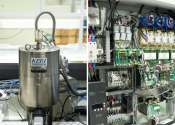New technique could lead to rewritable memory devices and low-power electronics
A research team led by Alex Zettl, senior faculty scientist in Berkeley Lab's Materials Sciences Division and professor of physics at UC Berkeley, has developed a new technique for fabricating tiny circuits from ultrathin ...
Oct 1, 2020
2
45









